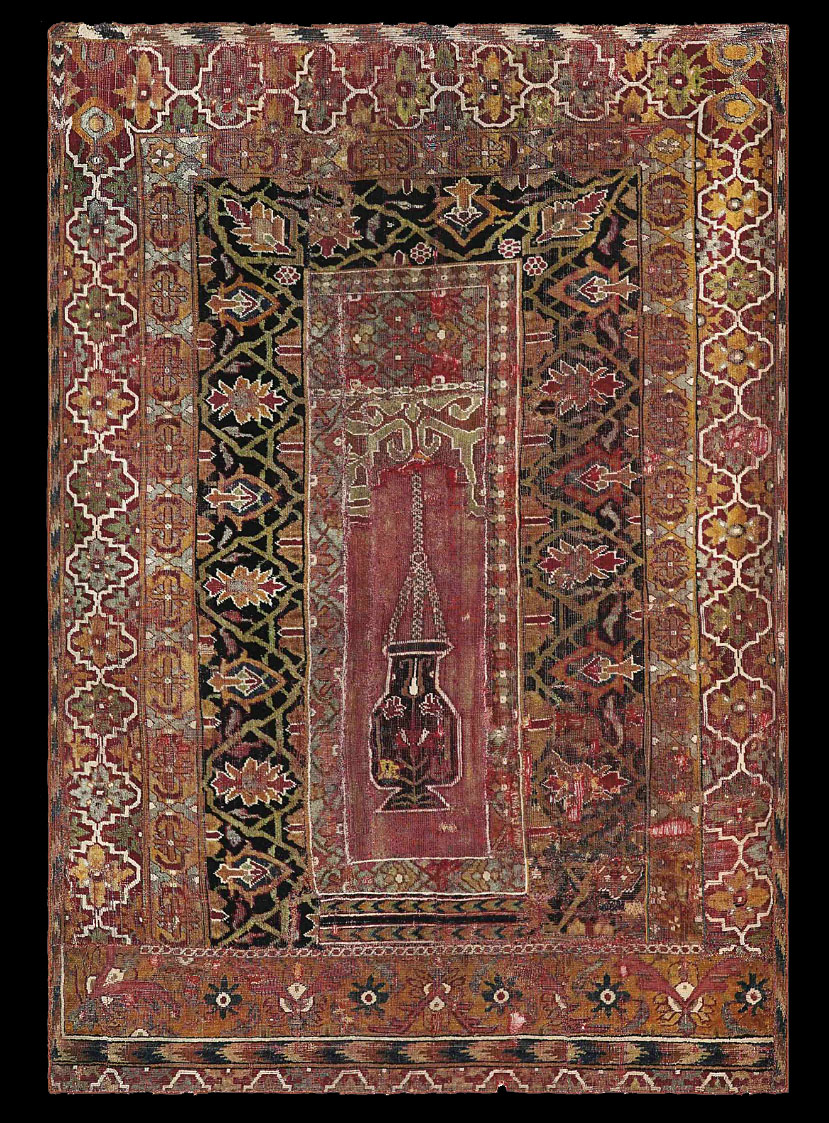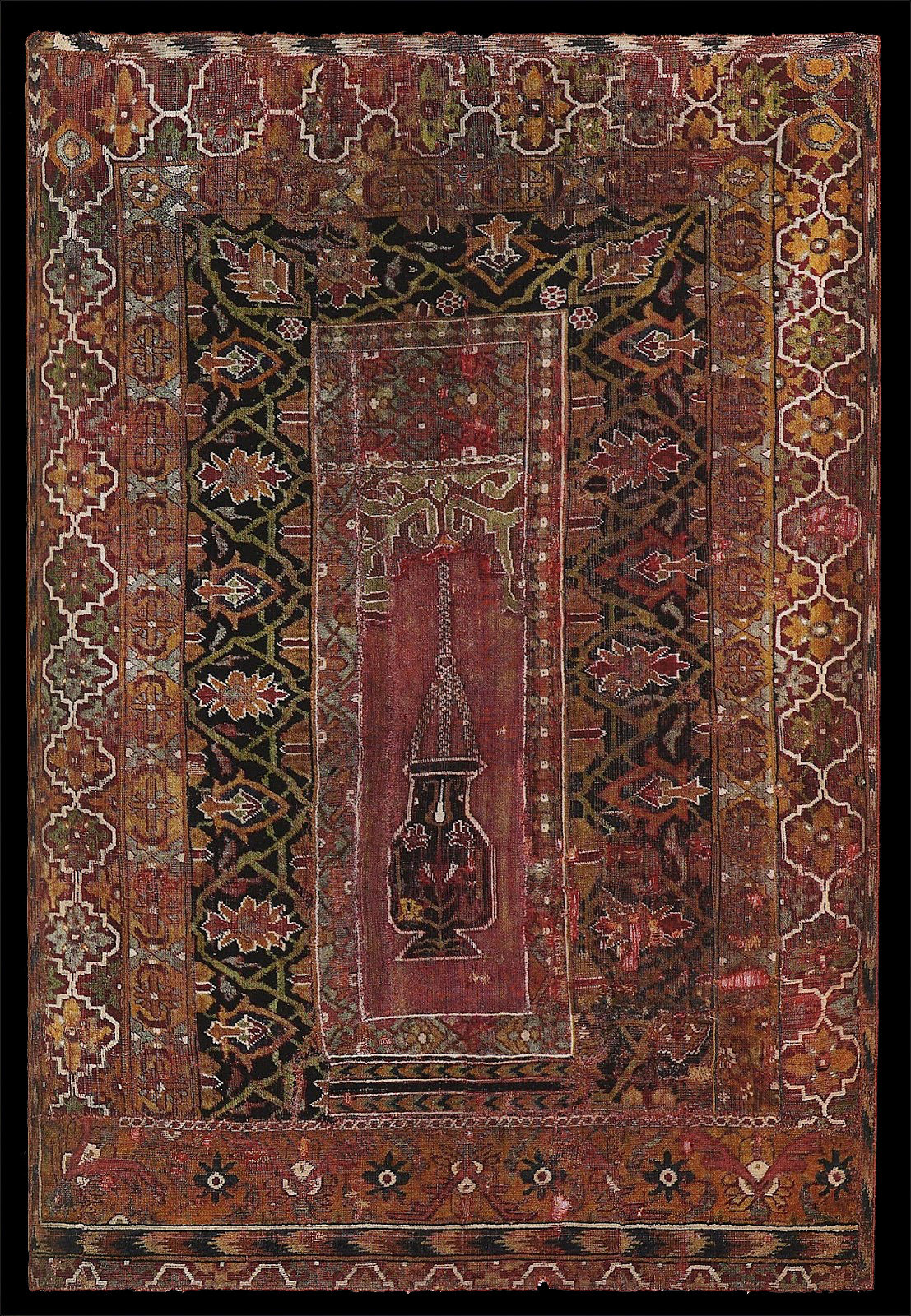A PART-COTTON OTTOMAN CAIRENE PRAYER RUG
EGYPT, LATE 17TH CENTURY
On silk foundation, composite from pieces of the same rug with two large
main parts describing the majority of the field and related borders, on silk
warps, partly full pile with areas of uneven wear and corrosion, some small
repairs, touches of related tinting, sides and ends secured
4ft.8in. x 3ft.4in. (142cm. x 102cm.)
Price Realized £37,250 ($57,514)
Sale Information
Christies SALE 7988 —
ORIENTAL RUGS AND CARPETS
4 October 2011
London, King Street
Lot Notes
This unique rug appears to be a rare 17th century Cairene weaving. It is
similar to the few 16th century Ottoman Cairene prayer rugs known to have
survived from the 16th century, but differs in certain aspects.
The form and decoration of the hanging lamp show the classic Ottoman quatre
fleurs seen in a condensed version filling the lamp here, just as they are
found for example in the Cairene prayer rug now in the al-Sabah Collection,
Kuwait (Eberhart Herrmann, Seltene Orientteppiche IV, Munich, 1982, no.1,
pp.58-59). The use of white cotton for details in the pile, the very soft
fleecy S-spun Z plied, the palette and the use of silk for the foundation
are all points in common between the two rugs. The silk may well have been
imported; it is Z-spun and S plied. There are however a few features that
preclude a 16th century Cairene attribution for this rug. The drawing
differs, and there are elements of the design that are unknown in 16th
century Ottoman art, notably the lower golden yellow border.
In 1674 the inventory of the Yeni Cami in Istanbul recorded that there were
many multiple prayer rugs there which had been commissioned from Egypt (Arménag
Bey Sakisian, 'L'inventaire des tapis de la mosquée Yeni-Djami de Stamboul',
Syria, 1931, pp.368-373; quoted by Louise Mackie in Richard Ettinghausen et
al, Prayer Rugs, exhibition catalogue, Washington D.C., 1974, no.VI, p.42).
Some of these had as many as 132 mihrabs while others had only ten. Multiple
prayer rugs (safs) with 132 niches must be placed in a 12 x 11 arrangement,
or maybe 6 x 22. Either of these would have been a massive carpet implying a
very large-scale operation with huge looms on which the carpets would have
been woven. Despite this, virtually no examples have survived from this
production. Before the appearance of the present rug the only examples that
have been linked with this 17th century Egyptian production are two
fragmentary safs in the Field Museum of Natural History (Ettinghausen op.cit
no.VI, pp.42-3).
The Chicago saf clearly draws all its design elements directly from Ottoman
prayer rug design. The present example however does not. It is considerably
more inventive in detail. The main border, with its powerful indigo ground
and in and out palmette design has a certain Persianate feel to it. This is
even more the case with the golden yellow lower border with its alternating
plant forms appearing almost like winged animals. Even here there is a
careful variation in the drawing where the inverted ones are very angular
while the upward pointing ones are far more curved. The element of a
palmette issuing curving serrated leaves which arch out to either side above
the palmette is one that can be seen for example on the Aberconway Polonaise
carpet (Arthur Upham Pope, A Survey of Persian Art, Oxford, 1938, pl.1252).
This again indicates a 17th century date for our prayer rug, and an eclectic
selection of sources for the design.
The present rug clearly relates to the Chicago safs; it is however
considerably finer woven, with more colours, better materials, and more
complex designs. It too appears to have been woven as a part of a multiple
prayer rug, but the quality of the materials would indicate that it is
unlikely to have been a part of a massive commission such as the Yeni Cami,
but rather a commission possibly for a special area of a mosque, or else for
a private foundation mosque.
A C14 test performed at the Rafter Laboratory New Zealand on warp samples
from this rug, ref NZA 36952, job no.106849 is consistent with the proposed
dating.
|

|


